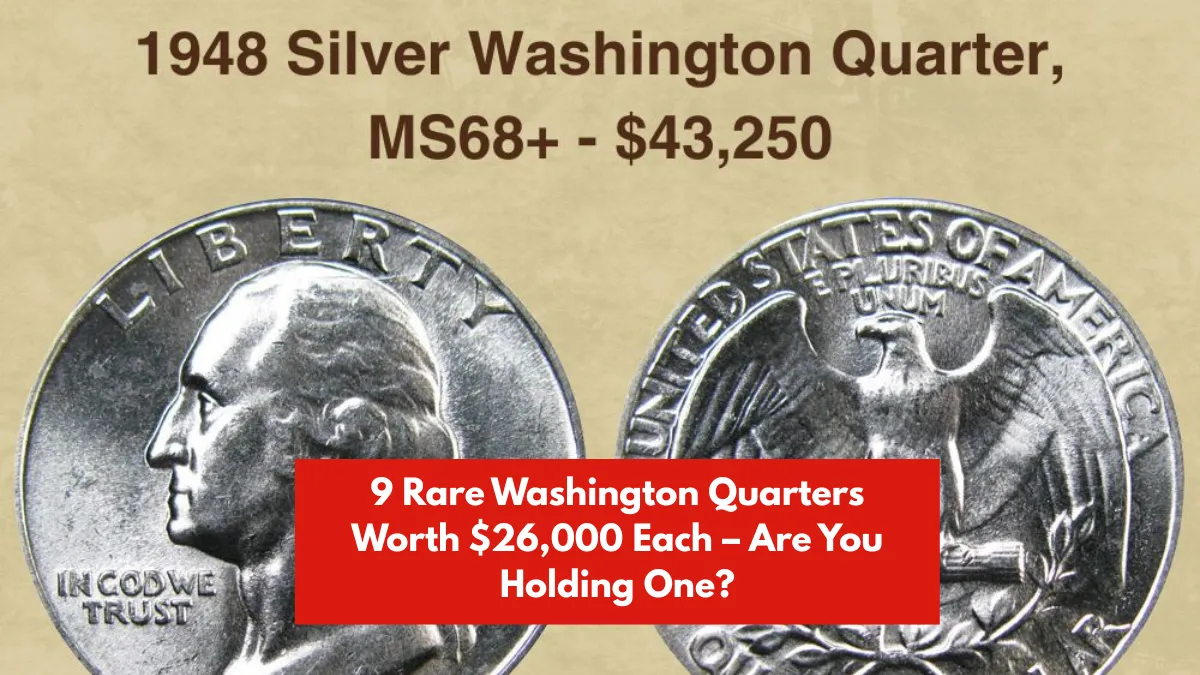This Quarter Might Be Worth $26,000 – And You Could Have One!
You might want to look at your spare change a little more closely. Some common-looking Washington quarters — the 25-cent pieces you toss into vending machines or keep in a jar — are actually worth thousands of dollars. In fact, a few are worth up to $26,000 each, and many people don’t even know they exist.
These quarters are special because of minting mistakes, rare features, or very limited production. Whether you’re just curious or have an old coin collection, here’s what you need to know about 9 rare Washington quarters that could be worth a fortune.
Why Are Some Quarters So Valuable?
The Washington quarter was first made in 1932 to celebrate George Washington’s 200th birthday. Most of these coins are worth just 25 cents — but a small number became valuable due to errors, special editions, or low mintage (how many were made).
Collectors pay big money for coins that are rare or have unusual traits. Even a small detail like a missing leaf or a doubled letter can raise a quarter’s value from pocket change to thousands of dollars.
Chart: 9 Rare Washington Quarters That Could Be Worth $26,000
| Year | Mint Mark | Why It’s Valuable | Estimated Value |
|---|---|---|---|
| 1932-D | D (Denver) | Very low number made | Up to $26,000 |
| 1932-S | S (San Francisco) | Also rare due to limited production | Over $25,000 |
| 1943-S | S | Double-die error on the front side | $15,000–$26,000 |
| 1950-D | D | Mint mark stamped twice (RPM error) | $10,000–$20,000 |
| 1964 | None | Silver content + transitional coin | $12,000–$26,000 |
| 1965 | None | Mistakenly made on a silver blank | $15,000–$20,000 |
| 1970-S | S | Struck on a 1941 Canadian coin (huge error) | Up to $26,000 |
| 1983-P | P | Double-die reverse + no mint set issued | $10,000–$25,000 |
| 2004-WI | None | Wisconsin coin with extra corn leaf | $6,000–$26,000 |
The Original Rarities: 1932-D & 1932-S
The 1932-D and 1932-S quarters were the first Washington quarters ever made — and very few were minted. That makes them extremely rare. If you have one in good shape, especially if it’s uncirculated, you could be holding a collector’s dream.
The Silver Quarters: 1964 & 1965
In 1964, quarters were made of 90% silver. The following year, the Mint switched to cheaper copper-nickel coins. However, a few 1965 quarters were accidentally made on silver blanks. These mix-up coins look normal but are far more valuable. To check, weigh the coin — silver quarters weigh more.
Error Quarters: Big Mistakes, Big Money
Coins with minting mistakes are called error coins, and they’re often worth a lot. Here are a few examples:
- Double-die quarters: The design was struck twice, causing blurry or doubled text.
- Repunched mint marks (RPM): The mint mark (like “D” or “S”) was stamped more than once.
- Overstruck coins: These were printed on the wrong coin blanks — like the 1970-S quarter struck on a 1941 Canadian quarter!
The Famous Wisconsin Quarter Error
In 2004, the U.S. released a Wisconsin state quarter. Some of them had an extra leaf on the corn stalk — a mistake that collectors love. There are two versions: one with an extra high leaf and one with a low leaf. Both are worth thousands today.
1983-P Quarter: No Mint Set + Error
In 1983, the Mint didn’t make any official mint sets. That means it’s hard to find a 1983-P quarter in excellent condition. On top of that, some had a double-die reverse, making them very rare and valuable to coin lovers.
FAQs
1. How can I tell if my quarter is rare?
Check the year and mint mark (usually a small letter near Washington’s neck). Then compare it to a list of rare quarters or have it checked by a coin expert.
2. Where is the mint mark on a quarter?
On quarters made before 1968, the mint mark is on the back near the bottom. After 1968, it moved to the front, right behind Washington’s neck.
3. Can I still find these quarters in circulation?
Yes! Some are still out there in circulation or hiding in old jars, bank rolls, or collections passed down from family.
4. Should I clean an old quarter before selling it?
No. Cleaning can damage the coin and lower its value. Collectors want coins in their original, untouched condition.
